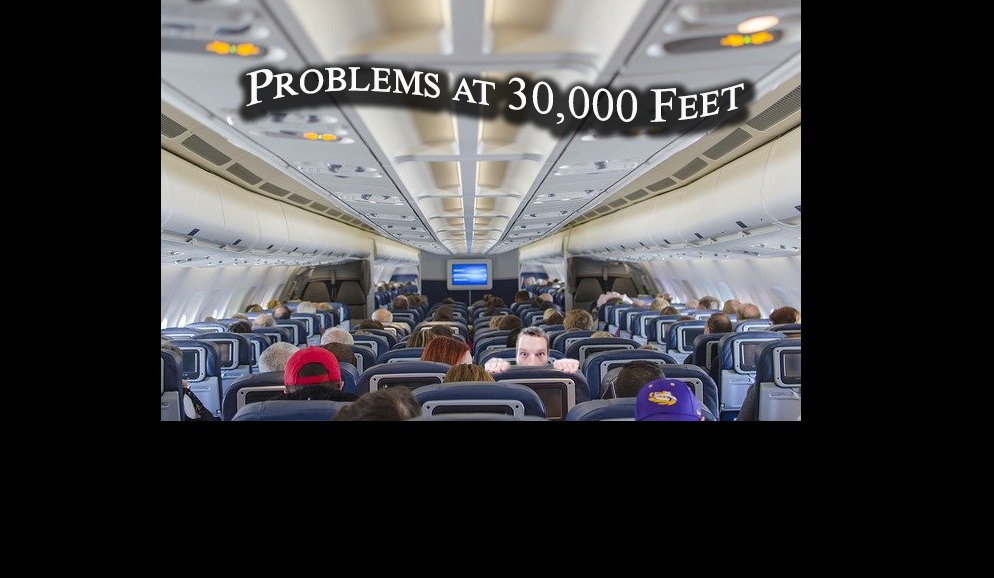Flying immediately after a night shift sounded like a good idea. A quiet flight, a nap on the plane, and escaping the endless Michigan winter by heading to Florida seemed brilliant.
The trip started well. Once airborne, my 20-month-old daughter and I fell asleep while my wife happily tinkered on her iPod. An hour later, my lovely wife woke me. My daughter’s internal calm-o-meter had detected everything going too smoothly. This automatically triggered the explosive bowel movement center in her brain.
Her outfit started out white.
It now looked like she had slid into third base on a wet field of asparagus and chocolate pudding. We maneuvered into the bathroom while holding our cute but stinky child with arms fully extended. Next problem? Tiny airplanes have no changing tables. Thus, my wife and child crammed into the mini-bathroom and matched wits. Imagine a small cage match of high-stakes fetid mud wrestling.
Shortly after, the pilot announced incoming turbulence. I returned to my seat while my wife frantically used 892 wipes on our soiled daughter.
VROOOOMP! (Monster turbulence hits the plane.) Overhead pilot voice: “If any doctors are on the flight, please come to the forward cabin.”
As an ED physician, I figured I should respond.
I tumbled my way to the front cabin despite the turbulence. I found one of the flight attendants lying flat in the aisle. Two doctors had already managed to get to her side. The first was a dermatologist who looked nervous. The other was a retired gastroenterologist who was roughly 109 years old. Both looked up at me and asked what type of physician I was.
“I’m an ER doctor,” I responded.
Poof! All I saw were two puffs of dust as they evaporated back to their seats.
I evaluated the flight attendant in the aisle. All of the other passengers watched the show taking place in front of them. Using some incredible diagnostic skills, I assessed the problem and came to the right conclusion – she fell.
At this time the other passengers, now overwhelmed with the desire to help, threw pillows at the flight attendant to help “support” her. Things quickly escalated out of control.
For some reason, pillows in the emergency department are always disappearing. Apparently, that is because every pillow in existence gets magically transported onto airplanes. In about 4 seconds, 23,277 pillows had piled on top us.
I dug her out of her pillowy sarcophagus long enough for a quick physical. Poof-poof, pillow to the face. She had no neurologic symptoms and no neck pain, just pain in her lower back. Other helpful passengers started draping blankets over her to “secure” her. So she lay in the aisle on her already hurt back, while turbulence periodically tossed her like a mummy-wrapped bingo ball.
I rechecked her neurologic status and suggested getting her to a seat. Poof-poof-poof, more pillows. She managed to get into a seat, where she seemed to recover quite well.
However, now I had to talk to the pilot. Due to tightened airplane security, I could not actually speak directly to him; I had to talk to him through a small phone, even though he was right behind the door. He asked if we needed to make an emergency landing.
For a second, I reveled in my power to have the plane landed. “No, I think we can just go to Florida,” I responded.
At this time, some helpful person handed me a box, which I assumed contained a defibrillator. I said “thank you.”
This is what you say whenever a stranger hands you a defibrillator.
My patient was doing great. Heading back to my seat, I was tempted to use the defibrillator just in case one more person chucked a pillow at me. (Here’s your pillow back BRRRZZZZAP!)
Everyone wanted news about the “dying” patient. I gave lots of thumbs-up and OK signs and quickly retold the story… That’s right. I’m a hero. I helped a nice lady into a chair.
When I got off, the pilot asked me to meet the front gate representative. Now I was worried. The flight attendant had been escorted off the plane by EMS. Did she get an anoxic brain injury from all the pillows?
As it turns out, they were just following protocol. They called me aside just to thank me for helping.
So what did I learn from my adventure? Well, I never figured out what to do with the defibrillator, but I did finally find a place to practice medicine that had enough pillows. I also learned that even when you are off duty, you are still an ER doc.

